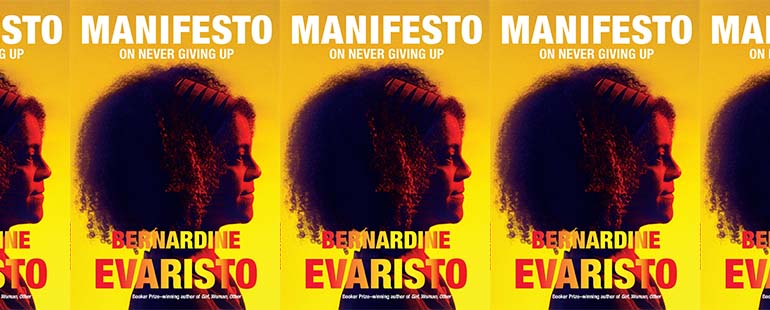A Feeling of Belonging in Bernardine Evaristo’s Manifesto

Manifesto
Bernardine Evaristo
Grove Atlantic | January 18, 2022
After Bernardine Evaristo’s Girl, Woman, Other won the Booker Prize in 2019—a historic occasion, Evaristo being the first Black woman and first Black British person ever to win the prize—the book became an instant classic. Now, in Evaristo’s debut nonfiction work, Manifesto, she explores the origins of her artistic life, as well as her writing philosophy. The memoir reflects on her time moving throughout London in her twenties and thirties, writing from numerous different flats. “My living situations and conditions, and my decision around earning money, had been a commitment to my creativity uber alles—and it worked,” she writes. During this time, Evaristo persists in valuing the creation of art over material comforts, making the act of writing her interior home. Manifesto explores this home, unraveling Evaristo’s journey and approach to making art.
The memoir is split into seven chapters detailing Evaristo’s artistic life, recalling how writing allowed her to explore her home and heritage, shaping her sense of self. Being raised by an English mother and an immigrant Nigerian father in central London, Evaristo recounts the confusion she felt as a child growing up in an interracial family. Evaristo’s father withheld details about his Nigerian ancestry and history from her and her siblings in the hopes of allowing his children to assimilate better into British society. Only later in life did Evaristo embark on a research journey of her father’s Nigerian background by writing her first semi-autobiographical verse novel from 1997, Lara, as a means to explore her heritage. The book centers on a bi-racial character who grows up in London and then travels down the Amazon to find out more about her African roots. Evaristo says that writing Lara allowed her to stop seeing her bi-racial identity in a bifurcated fashion. Instead, the telling of the story about the communities she came from allowed her to feel like a “fully integrated human being.”
Another way Evaristo feels fully integrated is through her love of acting. The memoir describes how acting was her first encounter with artistic self-expression and how it fueled her writing. In her early twenties, Evaristo graduated from theater school and started the Theatre of Black Women to empower Black women to receive opportunities within the theatrical sphere. “We didn’t wait to be picked,” she writes, “we made it happen for ourselves and for our community.” Leading a theatre company for many years provided Evaristo with a place to shape her feminist identity within the arts, as well as a communal space to express herself. Evaristo traces her “propensity as novelist” to write first-person narratives of varied personalities to her acting days that required her to develop “ventriloquist skills necessary to bring [fictional characters] alive” to an audience. She credits her writing stories about, “an Afro-Roman girl from eighteen hundred years ago, a septuagenarian gay Caribbean man, a fourteen-year-old schoolboy living on an estate, or a white slave woman living in a parallel universe,” to her study of acting, teaching her how to physically embody a diverse set of characters at a deep level.
The ethics of such embodiment is also a main focus of the memoir, examining the effects of critiquing society through another person’s perspective. She asks, “what are the ethics of policing the imagination when a person from one society explores another through fiction?” Evaristo feels that artists should explore and represent stories outside of their own “authentic” identity, that it is a dangerous path to essentialize identities “into notions of authenticity” as it limits the artist. For Evaristo, exploring identities through fictional characters is a way of making silenced voices heard. She does not shy away from producing genre-bending stories and characters that resist placement in neat categories.
Herein lies the primary aim of Evaristo’s work: to give everyone a feeling of belonging, especially those who are underrepresented. To this end, the memoir concludes with a passionate plea from Evaristo—titled the “Evaristo Manifesto”—for creatives to “have the opportunity to create, share & consume stories that reflect their cultures & communities, so that we all feel equally validated.” Evaristo’s memoir serves as proof of how one writer found her place in the world through storytelling, giving artists a roadmap to a deeper understanding of their own lives through the act of creating.



